Optimizing Lucerne Productivity and Resource Efficiency in China’s Yellow River Irrigated Region: Synergistic Effects of Ridge-Film Mulching and Controlled-Release Nitrogen Fertilization
Abstract
1. Introduction
2. Materials and Methods
2.1. Overview of the Experimental Site
2.2. Experimental Design
2.3. Measurement Indicators and Calculation Methods
2.3.1. Plant Height and Stem Diameter (cm)
2.3.2. Yield and Quality
2.3.3. Water and Nitrogen Use Efficiency
2.4. Data Analysis
3. Results
3.1. Growth Performance of Lucerne in Response to Planting and Nitrogen Application Patterns
3.1.1. Plant Height
3.1.2. Stem Diameter
3.2. Yield and Quality of Lucerne in Response to Planting Nitrogen Application Patterns
3.2.1. Yield
3.2.2. Quality
3.3. Lucerne Water and Nitrogen Utilization in Response to Planting Nitrogen Application Patterns
3.4. Comprehensive Evaluation
3.4.1. Correlation Analysis
3.4.2. Principal Component Analysis
4. Discussion
4.1. Synergistic Promotion Effects of Different Cropping Patterns and Nitrogen Application on Lucerne Growth
4.2. Effect of Cropping Pattern and Nitrogen Application on Yield and Quality of Lucerne
4.3. Improvement Effects of Optimized Cropping Pattern and Precision Nitrogen Application on Water and Nitrogen Use Efficiency of Lucerne
5. Conclusions
Author Contributions
Funding
Data Availability Statement
Acknowledgments
Conflicts of Interest
References
- Liu, J.; Lu, F.; Zhu, Y.; Wu, H.; Ahmad, I.; Dong, G.; Zhou, G.; Wu, Y. The effects of planting density and nitrogen application on the growth quality of alfalfa forage in saline soils. Agriculture 2024, 14, 302. [Google Scholar] [CrossRef]
- Altınok, S.; Yurtseven, E.; Avcı, S.; Öztürk, H.S.; Selenay, M.F. The effects of different irrigation water salinities and leaching ratios on green and dry forage yields of alfalfa (Medicago sativa L.). Agricult. Forestry. 2015, 61, 85–90. [Google Scholar] [CrossRef]
- Osterholz, W.R.; Renz, M.; Jokela, W.E.; Grabber, J.H. Interseeded alfalfa reduces soil and nutrient runoff losses during and after corn silage production. J. Soil Water Conserv. 2019, 12, 85–90. [Google Scholar] [CrossRef]
- Gu, Y.-J.; Han, C.-L.; Kong, M.; Shi, X.-Y.; Zdruli, P.; Li, F.-M. Plastic film mulch promotes high alfalfa production with phosphorus-saving and low risk of soil nitrogen loss. Field Crops Res. 2018, 229, 44–54. [Google Scholar] [CrossRef]
- Wan, W.; Li, Y.; Li, H. Yield and quality of alfalfa (Medicago sativa L.) in response to fertilizer application in China: A meta-analysis. Front. Plant Sci. 2022, 13, 1051725. [Google Scholar] [CrossRef]
- Lu, J.Y.; Xiong, J.B.; Zhang, H.S.; Tian, H.; Yang, H.M.; Liu, Y. Effects of water stress on yield, quality and trace element composition of alfalfa. Acta Pratac. Sin. 2020, 29, 126–133. [Google Scholar]
- Lv, Y.; Wang, J.; Yin, M.; Kang, Y.; Ma, Y.; Jia, Q.; Qi, G.; Jiang, Y.; Lu, Q.; Chen, X. Effects of planting and nitrogen application patterns on alfalfa yield, quality, water-nitrogen use efficiency, and economic benefits in the Yellow River irrigation region of Gansu Province, China. Water 2023, 15, 251. [Google Scholar] [CrossRef]
- Rahman, A.; Yong-Goo, K.; Iftekhar, A.; Liu, G.-S.; Hyoshin, L.; Joo, L.J.; Byung-Hyun, L. Proteome analysis of alfalfa roots in response to water deficit stress. J. Integr. Agric. 2016, 15, 1275–1285. [Google Scholar] [CrossRef]
- Wang, Q.; Zhang, E.; Li, F.; Li, F. Runoff efficiency and the technique of micro-water harvesting with ridges and fur-rows, for potato production in semi-arid areas. Water Resour. Manag. 2008, 22, 1431–1443. [Google Scholar] [CrossRef]
- Li, F.M.; Wang, P.; Wang, J.; Xu, J.Z. Effects of irrigation before sowing and plastic film mulching on yield and water uptake of spring wheat in semiarid Loess Plateau of China. Agric. Water Manag. 2004, 67, 77–88. [Google Scholar] [CrossRef]
- Kou, J.T.; Shi, S.L.; Cai, Z.S. Effects of ridge and furrow rainfall harvesting on growth characteristics and quality of Medicago sativa in dryland. China Agric. Sci. 2010, 43, 5028–5036. [Google Scholar]
- Xie, J.; Wang, L.; Li, L.; Anwar, S.; Luo, Z.; Zechariah, E.; Fudjoe, S.K. Yield, economic benefit, soil water balance, and water use efficiency of intercropped maize/potato in responses to mulching practices on the semiarid loess plateau. Agriculture 2021, 11, 1100. [Google Scholar] [CrossRef]
- Liu, X.E.; Li, X.G.; Hai, L.; Wang, Y.P.; Fu, T.T.; Turner, N.C.; Li, F.M. Film-mulched ridge–furrow management increases maize productivity and sustains soil organic carbon in a dryland cropping system. Soil Sci. Soc. Am. J. 2014, 78, 1434–1441. [Google Scholar] [CrossRef]
- Li, T.L.; Xie, Y.H.; Ren, M.M.; Deng, S.Y.; Dan, J.; Lei, Z.Y.; Hong, J.P.; Wang, C.H. Effects of fertilization and plastic film mulched ridge-furrow cultivation on yield and water and nitrogen utilization of winter wheat on dryland. Ecol. J. 2011, 31, 212–220. [Google Scholar]
- Wang, T.H.; Li, Y.N. Effect of furrow planting winter wheat with plastic film mulching on water-use efficiency and soil temperature. China Rural. Water Hydropower. 2011, 1, 46–49. [Google Scholar]
- Song, Z.; Guo, J.; Zhang, Z.; Kou, T.; Deng, A.; Zheng, C.; Ren, J.; Zhang, W. Impacts of planting systems on soil moisture, soil temperature and corn yield in rainfed area of Northeast China. Eur. J. Agron. 2013, 50, 66–74. [Google Scholar] [CrossRef]
- Farrell, A.D.; Gilliland, T.J. Yield and quality of forage maize grown under marginal climatic conditions in Northern Ireland. Grass Forage Sci. 2011, 66, 214–223. [Google Scholar] [CrossRef]
- Liu, E.K.; He, W.Q.; Yan, C.R. ‘White revolution’ to ‘white pollution’—Agricultural plastic film mulch in China. Environ. Res. Lett. 2014, 9, 091001. [Google Scholar] [CrossRef]
- Yin, G.H.; Hao, L.; Zhao, Y.H.; Gu, J.; Liu, Z.X. Effects of hydromulching on soil water availability. Chin. J. Ecol. 2013, 32, 1405–1411. [Google Scholar]
- Li, H.; Chang, W. Exploring optimal film mulching to enhance potato yield in China: A meta-analysis. Agron. J. 2021, 113, 4099–4115. [Google Scholar] [CrossRef]
- Laura, M.L.; Scott, L.C.; Amaris, L.S.; Yang, X.; Michael, F.A.; Edith, B.A. Above- and belowground responses to nitrogen addition in a Chihuahuan Desert grassland. Oecologia 2011, 169, 177–185. [Google Scholar]
- Liu, X.J.; Liu, Y.N.; Kuai, J.L.; Qi, M.X.; Zhang, X.L. Effects of different N levels on productivity and quality of alfalfa varieties. Acta Agrestia Sin. 2013, 21, 702–707. [Google Scholar]
- Geng, J.; Sun, Y.; Zhang, M.; Li, C.; Yang, Y.; Liu, Z.; Li, S. The Long-term effects of controlled release urea application on crop yields and soil fertility under rice-oilseed rape rotation system. Field Crops Res. 2015, 184, 65–73. [Google Scholar] [CrossRef]
- Tubeileh, A.M.-S.; Alam-Eldein, S.M.; Banks, S. Effect of polymer-coated urea/urea blends on corn yields under short growing season conditions in Eastern Canada. Agronomy 2023, 13, 695. [Google Scholar] [CrossRef]
- Wang, H.; Zhang, M.; Yin, X.H.; Fu, W. Nitrogen leaching loss of controlled-release fertilizers on ryegrass turfgrass. J. Soil Water Conserv. 2009, 23, 017. [Google Scholar]
- Zhang, R.; Zhang, H.; Xing, Y.; Xue, L. Optimizing plastic film mulch to improve the yield and water use efficiency of dryland maize in the Loess Plateau, China. PLoS ONE 2024, 19, e0308706. [Google Scholar] [CrossRef]
- Zhao, H.; Wang, R.-Y.; Ma, B.-L.; Xiong, Y.-C.; Qiang, S.-C.; Wang, C.-L.; Liu, C.-A.; Li, F.-M. Ridge-furrow with full plastic film mulching improves water use efficiency and tuber yields of potato in a semiarid rainfed ecosystem. Field Crops Res. 2014, 161, 137–148. [Google Scholar] [CrossRef]
- Zhou, L.-M.; Zhang, F.; Liu, C.-A. Improved yield by harvesting water with ridges and subgrooves using buried and surface plastic mulches in a semiarid area of China. Soil Tillage Res. 2015, 150, 21–29. [Google Scholar] [CrossRef]
- Chen, D.D.; Wang, Y.R.; Han, Y.H. Effects of irrigation frequency and fertilizer rate on alfalfa seed yields in the Yellow River irrigated region. Acta Prataculturae Sin. 2016, 25, 154–163. [Google Scholar]
- Zhang, Z.Q.; Jiao, J.Y.; Chen, T.D.; Chen, Y.L.; Lin, H.; Xu, Q.; Cheng, Y.Z.; Zhao, W.T. Soil nutrient evaluation of alluvial fan in the middle and lower reaches of Lhasa River Basin. J. Plant Nutr. Fertil. 2022, 28, 2082–2096. [Google Scholar]
- Van Soest, P.J.; Robertson, J.B.; Lewis, B.A. Methods for dietary fiber, neutral detergent fiber, and nonstarch polysaccharides in relation to animal nutrition. J. Dairy. Sci. 1991, 74, 3583–3597. [Google Scholar] [CrossRef]
- Li, N.; Zhou, C.; Sun, X.; Jing, J.; Tian, X.; Wang, L. Effects of ridge tillage and mulching on water availability, grain yield, and water use efficiency in rain-fed winter wheat under different rainfall and nitrogen conditions. Soil Tillage Res. 2018, 179, 86–95. [Google Scholar] [CrossRef]
- Xin, X.; Sun, Z.; Xiao, J.; Bai, W.; Zhang, Z.; Yan, H. Efficient utilization mechanism of soil moisture and nutrients with ridge film furrow seeding technology of sloping farmlands in semi-arid and rain-fed areas. Agriculture 2023, 13, 1940. [Google Scholar] [CrossRef]
- Beres, B.L.; Stevenson, F.C. Feasibility of bioplastic mulch systems to stimulate early seed germination and plant growth for corn silage hybrids. Can. J. Plant Sci. 2015, 95, 1229–1234. [Google Scholar] [CrossRef]
- Yu, X.J.; Chai, J.L.; Xu, C.L.; Shi, S.L.; Xiao, H.; Ma, L.X.; Cao, G.S. Effects of different planting methods on growth of alfalfa and weeds in Gannan Alpine Region. Scientia Agric. Sin. 2016, 49, 791–801. [Google Scholar]
- Kang, Y.; Qi, G.; Jia, Q.; Wang, A.; Yin, M.; Ma, Y.; Wang, J.; Jiang, Y.; Tang, Z. Appropriate water-nitrogen regulation mode to improve productivity of mixed-sowing grassland of bromus inermis and alfalfa. Water 2023, 15, 1124. [Google Scholar] [CrossRef]
- Lu, F.G.; Gu, L.F.; Liu, Y.Q.; Ren, Z.; Shi, Y.; Xu, Z.R.; Zhou, G.S.; Lu, H.T.; Wang, X.S.; Zhang, W.D.; et al. Interaction effects of plant density and nitrogen rate on the growth and physiological traits of alfalfa in saline alkali soils. Acta Prataculturae Sin. 2021, 38, 1570–1578. [Google Scholar]
- Kamran, M.; Yan, Z.; Jia, Q.; Chang, S.; Ahmad, I.; Ghani, M.U.; Hou, F. Irrigation and nitrogen fertilization influence on alfalfa yield, nutritive value, and resource use efficiency in an arid environment. Field Crops Res. 2022, 284, 108587. [Google Scholar] [CrossRef]
- Qin, S.; Zhang, J.; Dai, H.; Wang, D.; Li, D. Effect of ridge-furrow and plastic-mulching planting patterns on yield formation and water movement of potato in a semi-arid area. Agric. Water Manag. 2014, 131, 87–94. [Google Scholar] [CrossRef]
- Cheng, J.; Wan, H.; Wang, J. Alfalfa growth and its relation with soil water status in loess hilly and gully region. Chin. J. Appl. Ecol. 2005, 16, 435–438. [Google Scholar]
- Moreno, M.; Moreno, A. Effect of different biodegradable and polyethylene mulches on soil properties and production in a tomato crop. Sci. Hortic. 2008, 116, 256–263. [Google Scholar] [CrossRef]
- de Oliveira, W.S.; Oliveira, P.P.A.; Corsi, M.; Duarte, F.R.S.; Tsai, S.M. Alfalfa yield and quality as function of nitrogen fertilization and symbiosis with Sinorhizobium meliloti. Sci. Agric. 2004, 61, 433–438. [Google Scholar] [CrossRef]
- Li, S.; Liu, Z. Fertilisation and environmental factors affect the yield and quality of alfalfa in China. Plant Soil Environ. 2024, 70, 276–286. [Google Scholar] [CrossRef]
- Yin, M.H.; Ma, Y.L.; Kang, Y.X.; Jia, Q.; Qi, G.P.; Wang, J.H. Effects of nitrogen application on alfalfa yield and quality in China-A Meta-analysis. Acta Prataculturae Sin. 2022, 31, 36–49. [Google Scholar]
- Fan, X.; Lu, C.; Khan, Z.; Li, Z.; Duan, S.; Shen, H.; Fu, Y. Mixed ammonium-nitrate nutrition regulates enzymes, gene expression, and metabolic pathways to improve nitrogen uptake, partitioning, and utilization efficiency in rice. Plants 2025, 14, 611. [Google Scholar] [CrossRef]
- Koskei, K.; Munyasya, A.N.; Wang, Y.B.; Zhao, Z.Y.; Zhou, R.; Indoshi, S.N.; Wang, W.; Cheruiyot, W.K.; Mburu, D.M.; Nyende, A.B.; et al. Effects of increased plastic film residues on soil properties and crop productivity in agro-ecosystem. J. Hazard. Mater. 2021, 414, 125521. [Google Scholar] [CrossRef]
- Gao, F.; Gao, T.G.; Zhu, B.C. Research progress on effects of nitrogen application on soybean nodulation, nitrogen fixation and yield. Jiangsu J. Agric. Sci. 2022, 50, 42–48. [Google Scholar]
- Miguel, C.; Shannon, D. Forage Quality: Concepts and Practices; North Carolina State University: Raleigh, NC, USA, 2014; p. AG-792. [Google Scholar]
- Hassanli, A.M.; Ebrahimizadeh, M.A.; Beecham, S. The effects of irrigation methods with effluent and irrigation scheduling on water use efficiency and corn yields in an arid region. Agric. Water Manag. 2009, 96, 93–99. [Google Scholar] [CrossRef]
- Qian, Z.H.; Han, B.F.; Liu, Z.T.; Cai, W.; Fu, B.Z.; Ma, H.B. Effects of infiltration irrigation on growth characters and water use efficiency of alfalfa in the Ningxia Yellow River diversion irrigation area. Acta Pratac. Sin. 2020, 29, 147–156. [Google Scholar]
- Wu, L.F.; Zhang, F.C.; Zhou, H.M.; Suo, Y.S.; Xue, F.D.; Zhou, J.W.; Liang, F. Effect of drip irrigation and fertilizer application on water use efficiency and cotton yield in North of Xinjiang. Trans. Chin. Soc. Agric. Eng. 2014, 30, 137–146. [Google Scholar]
- Govindasamy, P.; Muthusamy, S.K.; Bagavathiannan, M.; Mowrer, J.; Jagannadham, P.T.K.; Maity, A.; Halli, H.M.; Sujayananad, G.K.; Vadivel, R.; Das, T.K.; et al. Nitrogen use efficiency—A key to enhance crop productivity under a changing climate. Front. Plant Sci. 2023, 14, 1121073. [Google Scholar] [CrossRef] [PubMed]
- Huo, H.L.; Wang, Q.; Shi, S.L.; Ren, X.; Wang, H.L.; Wang, T.T.; Liu, Q.L. Effects of different rainwater harvesting planting methods on alfalfa cultivation in arid areas. Chin. J. Appl. Ecol. 2013, 24, 2770–2778. [Google Scholar]
- Feng, M.; Yu, C.; Lin, L.G.; Wu, D.Q.; Song, R.; Liu, H.X. Effects of water and nitrogen fertilizer on biomass distribution and water use efficiency of alfalfa (Medicago sativa) in Hexi Corridor. Chin. J. Eco-Agric. 2016, 24, 1623–1632. [Google Scholar]
- Abbasi, M.K.; Tahir, M.M.; Sadiq, A.; Iqbal, M.; Zafar, M. Yield and nitrogen use efficiency of rainfed maize response to splitting and nitrogen rates in Kashmir, Pakistan. Agron. J. 2012, 104, 448–457. [Google Scholar] [CrossRef]
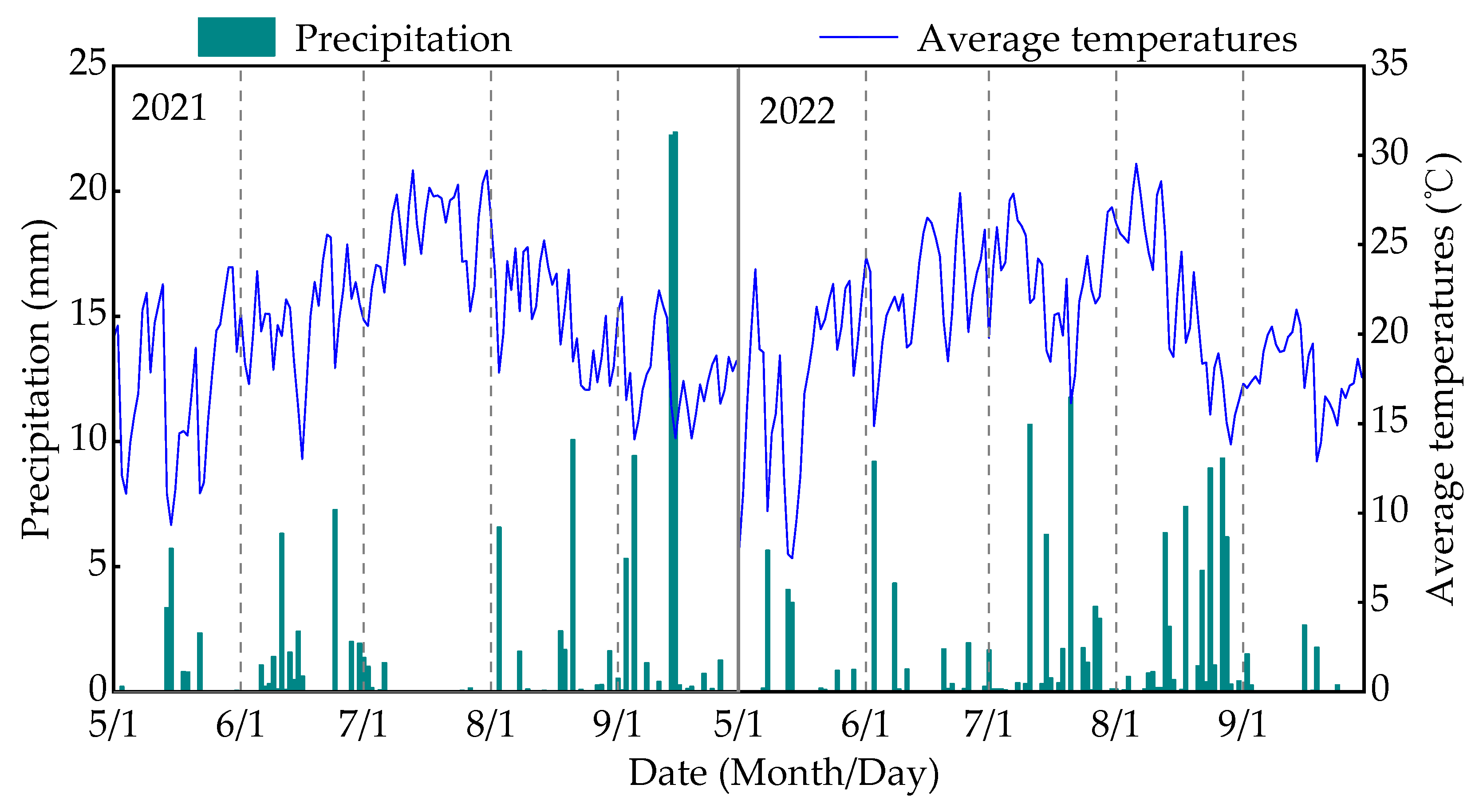
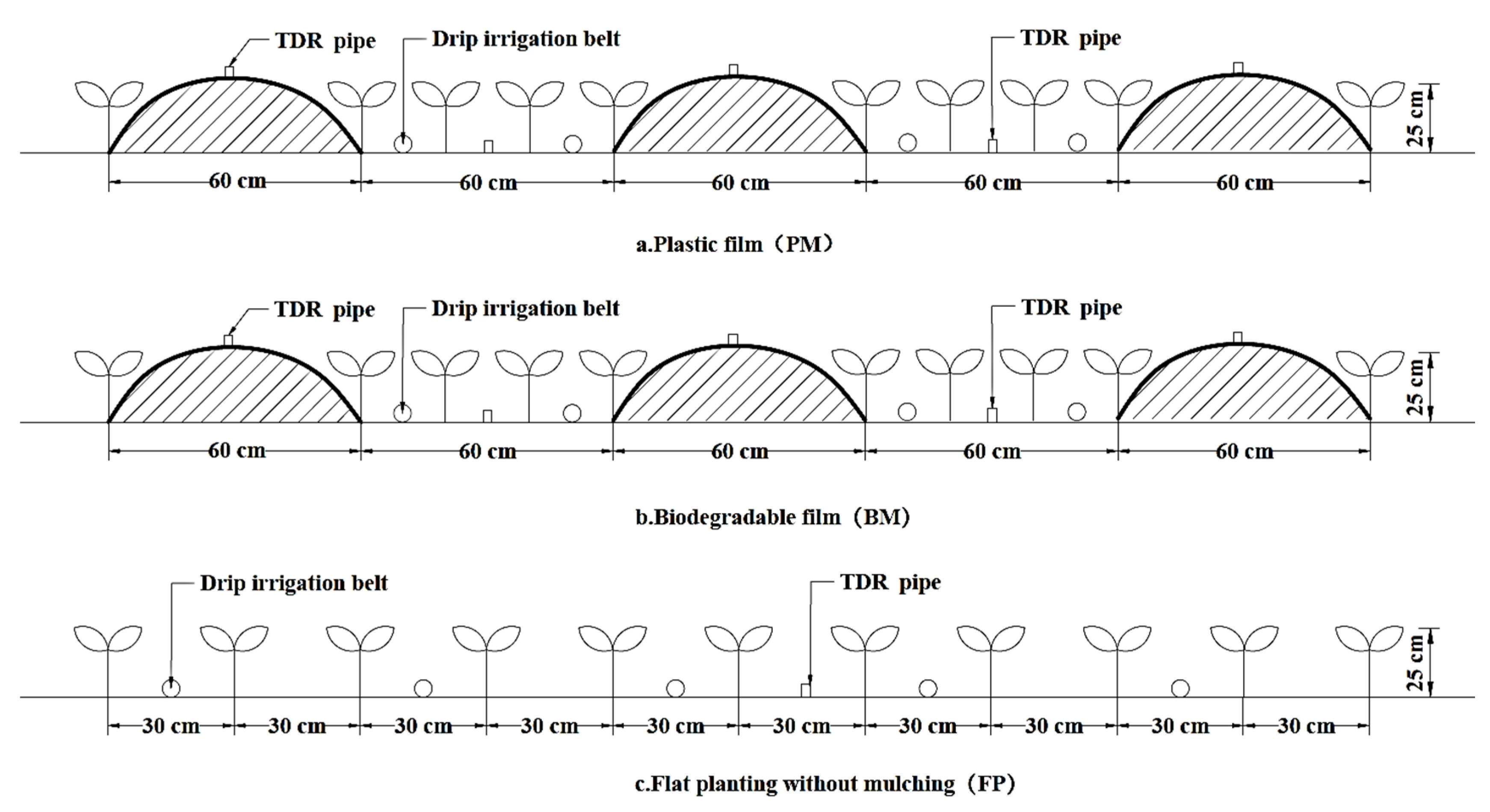


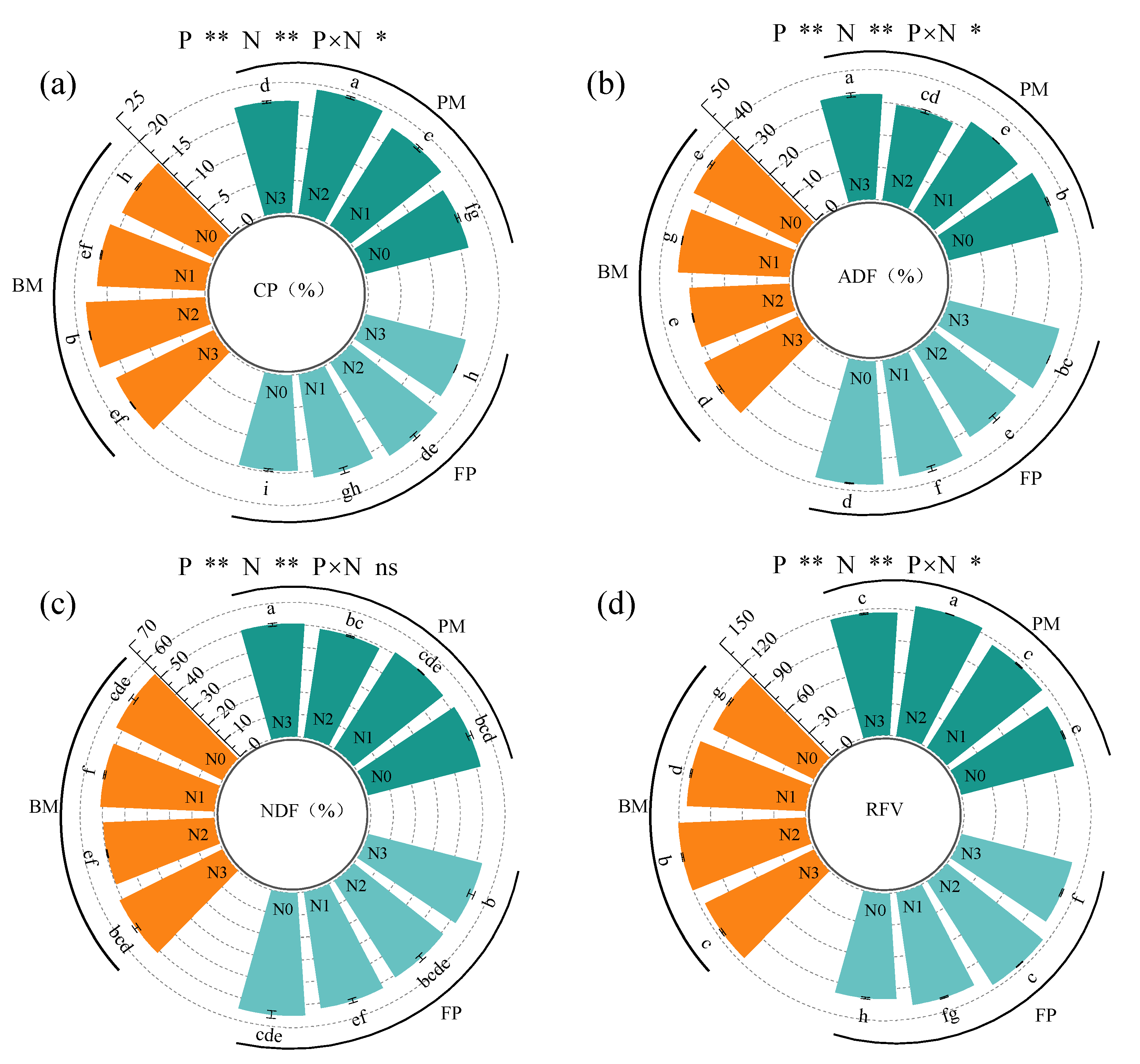
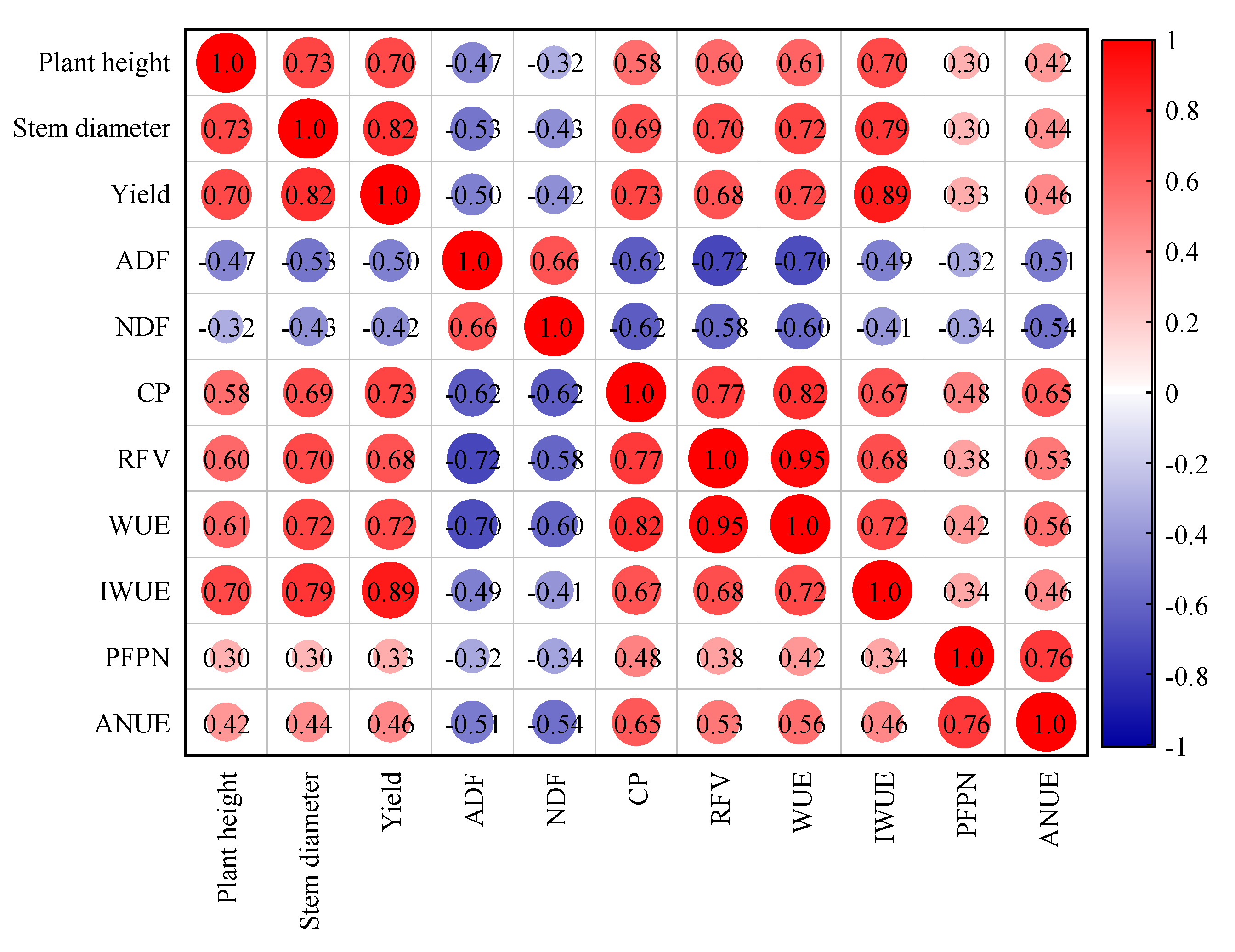
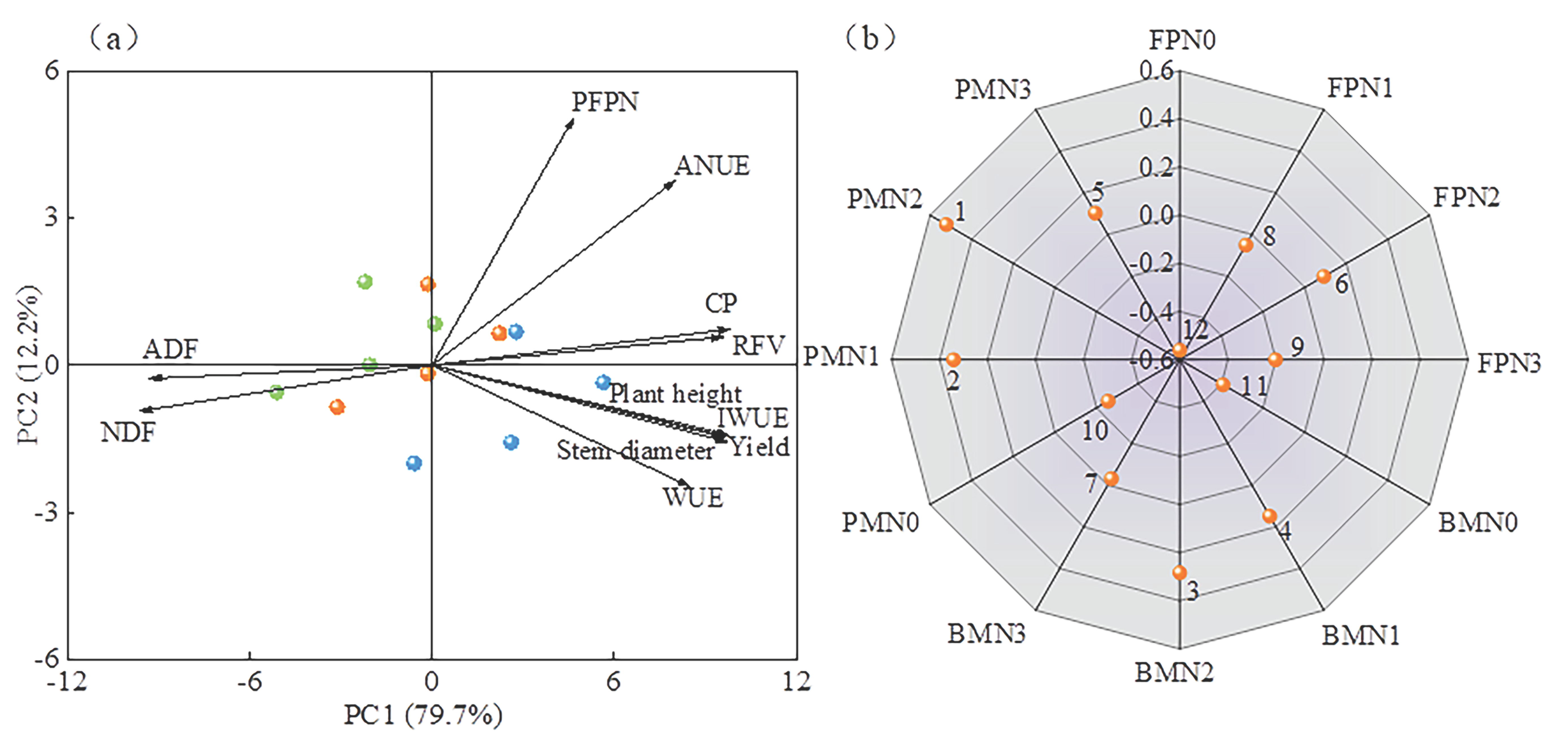
| Treatment | Cultivation Pattern | Nitrogen Level (kg·ha−1) |
|---|---|---|
| FPN0 | Traditional flat planting (FP) | 0 (N0) |
| FPN1 | 80 (N1) | |
| FPN2 | 160 (N2) | |
| FPN3 | 240 (N3) | |
| BMN0 | Ridge-furrow planting with biodegradable film (BM) | 0 (N0) |
| BMN1 | 80 (N1) | |
| BMN2 | 160 (N2) | |
| BMN3 | 240 (N3) | |
| PMN0 | Ridge-furrow planting with ordinary plastic film (PM) | 0 (N0) |
| PMN1 | 80 (N1) | |
| PMN2 | 160 (N2) | |
| PMN3 | 240 (N3) |
| Treatment | 2021 | 2022 | ||||||
|---|---|---|---|---|---|---|---|---|
| Planting Pattern | Nitrogen Level | First Cut | Second Cut | Total Yield | First Cut | Second Cut | Third Cut | Total Yield |
| PM | N0 | 4990 c | 2370 bc | 7370 c | 10,400 c | 5460 de | 2300 c | 18,100 c |
| N1 | 5490 b | 2480 ab | 7940 b | 11,400 a | 5900 b | 2350 bc | 19,700 b | |
| N2 | 5930 a | 2540 a | 8500 a | 12,000 a | 6270 a | 2430 a | 20,700 a | |
| N3 | 5710 ab | 2430 abc | 8140 b | 11,200 ab | 6170 a | 2380 ab | 19,700 b | |
| BM | N0 | 4430 f | 1940 e | 6370 gh | 9290 ef | 4800 g | 1940 f | 16,200 f |
| N1 | 4730 cde | 2250 d | 6980 de | 9520 cdef | 5420 de | 2090 de | 17,200 e | |
| N2 | 4820 cd | 2350 cd | 7170 cd | 10,500 bc | 5640 c | 2150 d | 18,300 c | |
| N3 | 4540 def | 2240 d | 6780 ef | 9880 cde | 5530 cd | 2100 de | 17,500 d | |
| FP | N0 | 4380 f | 1770 f | 6150 h | 8890 f | 4710 g | 1880 f | 15,500 g |
| N1 | 4460 ef | 1840 ef | 6300 gh | 9440 def | 5070 f | 1880 f | 16,400 f | |
| N2 | 4640 def | 1950 e | 6590 fg | 10,200 cd | 5360 e | 2050 e | 17,600 d | |
| N3 | 4670 def | 1920 e | 6590 fg | 9770 cde | 5150 f | 1920 f | 16,900 e | |
| P | ** | ** | ** | ** | ** | ** | ** | |
| N | ** | ** | ** | ** | ** | ** | ** | |
| P × N | ** | ** | * | ns | * | * | * | |
| Cultivation Pattern (P) | Nitrogen Level (N) | WUE (kg·ha–1·mm–1) | IWUE (kg·ha–1·mm–1) | PFPN (kg·kg–1) | ANUE (kg·kg–1) |
|---|---|---|---|---|---|
| PM | N0 | 2.73 ± 0.78 b | 3.51 ± 0.31 c | ||
| N1 | 2.99 ± 1.25 a | 3.81 ± 0.11 b | 172.69 ± 0.18 a | 4.54 ± 0.65 b | |
| N2 | 3.05 ± 0.61 a | 4.02 ± 0.66 a | 91.10 ± 1.41 d | 5.44 ± 0.27 a | |
| N3 | 2.95 ± 0.36 a | 3.84 ± 0.32 b | 58.00 ± 0.33 f | 1.96 ± 0.45 ef | |
| BM | N0 | 1.98 ± 0.32 de | 3.08 ± 0.66 e | ||
| N1 | 2.09 ± 1.19 d | 3.33 ± 1.3 d | 151.10 ± 6.43 b | 3.81 ± 0.50 bc | |
| N2 | 2.24 ± 0.20 c | 3.50 ± 0.26 c | 79.51 ± 0.58 e | 4.04 ± 0.45 b | |
| N3 | 1.96 ± 0.62 e | 3.34 ± 0.72 d | 50.61 ± 1.16 g | 1.58 ± 0.24 f | |
| FP | N0 | 1.39 ± 0.47 h | 2.98 ± 0.59 f | ||
| N1 | 1.60 ± 0.25 g | 3.12 ± 0.95 e | 141.83 ± 4.14 c | 2.65 ± 0.68 de | |
| N2 | 1.80 ± 0.1 f | 3.32 ± 0.08 d | 75.73 ± 0.22 e | 3.25 ± 0.22 cd | |
| N3 | 1.70 ± 0.2 fg | 3.24 ± 0.37 d | 49.03 ± 0.65 g | 1.50 ± 0.15 f | |
| P | ** | ** | ** | ** | |
| N | ** | ** | ** | ** | |
| P × N | ** | ns | ** | ** | |
Disclaimer/Publisher’s Note: The statements, opinions and data contained in all publications are solely those of the individual author(s) and contributor(s) and not of MDPI and/or the editor(s). MDPI and/or the editor(s) disclaim responsibility for any injury to people or property resulting from any ideas, methods, instructions or products referred to in the content. |
© 2025 by the authors. Licensee MDPI, Basel, Switzerland. This article is an open access article distributed under the terms and conditions of the Creative Commons Attribution (CC BY) license (https://creativecommons.org/licenses/by/4.0/).
Share and Cite
Yin, M.; Jiang, Y.; Ling, Y.; Ma, Y.; Qi, G.; Kang, Y.; Wang, Y.; Lu, Q.; Shang, Y.; Fan, X.; et al. Optimizing Lucerne Productivity and Resource Efficiency in China’s Yellow River Irrigated Region: Synergistic Effects of Ridge-Film Mulching and Controlled-Release Nitrogen Fertilization. Agriculture 2025, 15, 845. https://doi.org/10.3390/agriculture15080845
Yin M, Jiang Y, Ling Y, Ma Y, Qi G, Kang Y, Wang Y, Lu Q, Shang Y, Fan X, et al. Optimizing Lucerne Productivity and Resource Efficiency in China’s Yellow River Irrigated Region: Synergistic Effects of Ridge-Film Mulching and Controlled-Release Nitrogen Fertilization. Agriculture. 2025; 15(8):845. https://doi.org/10.3390/agriculture15080845
Chicago/Turabian StyleYin, Minhua, Yuanbo Jiang, Yi Ling, Yanlin Ma, Guangping Qi, Yanxia Kang, Yayu Wang, Qiang Lu, Yujie Shang, Xiangrong Fan, and et al. 2025. "Optimizing Lucerne Productivity and Resource Efficiency in China’s Yellow River Irrigated Region: Synergistic Effects of Ridge-Film Mulching and Controlled-Release Nitrogen Fertilization" Agriculture 15, no. 8: 845. https://doi.org/10.3390/agriculture15080845
APA StyleYin, M., Jiang, Y., Ling, Y., Ma, Y., Qi, G., Kang, Y., Wang, Y., Lu, Q., Shang, Y., Fan, X., Han, G., Li, B., Zhu, J., Chen, J., & Li, H. (2025). Optimizing Lucerne Productivity and Resource Efficiency in China’s Yellow River Irrigated Region: Synergistic Effects of Ridge-Film Mulching and Controlled-Release Nitrogen Fertilization. Agriculture, 15(8), 845. https://doi.org/10.3390/agriculture15080845







